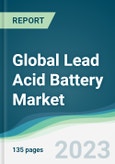The global lead acid battery market is expected to grow at a CAGR of 3.78%, increasing from US$38.225 billion in 2021 to reach US$49.565 billion in 2028.
Lead acid batteries are mostly used in submarine electrical installations, starting, lighting, and ignition systems for cars and UPS systems. Lead, and sulfuric acid undergo a chemical reaction in a lead acid battery that produces electricity that meets the many electrical requirements of a motor vehicle. The lead-acid battery demand will increase due to rising electric vehicle sales and the demand for reliable power for essential applications, boosting the overall market growth. The lead acid battery market is being driven by the increased demand for energy storage systems due to the increased usage of electrical devices such as mobile phones, power banks, and electronic gadgets around the world, as well as advanced marine propulsion technology and increased elevator use which is acting as an additional driving factor.The growing marine sector is contributing to the market expansion.
Electricity can be stored conveniently with a lead acid battery in the ships. It serves as a readily accessible emergency supply on many vessels in the marine sector and can also be regularly utilized to give specific equipment a low-voltage DC supply. The growing shipbuilding and investments will boost the lead acid battery market growth during the forecasted period. According to information from the U.S. Census Bureau Report 2021, the private shipbuilding and repair sector in the United States is predicted to have spent $896.3 million on new and used capital assets in 2019. The new shipbuildings and equipment account for most industrial capital expenditures, and the sector spent an estimated $873.4 million on new shipbuilding production in 2019. According to the China Association of the National Shipbuilding Industry (CANSI), China accounted for 45.5% of the global market for shipbuilding completion, with 53.1% of new orders and 48.5% of existing orders. The growing marine shipbuilding will boost the demand for lead-acid batteries, driving market growth during the forecasted period.Increasing investments in the electric vehicles sector is boosting the market growth.
The growing concerns about conventional cars' impact on the environment continue to grow, and governments worldwide are encouraging the use of alternative fuel vehicles. EVs, or electric cars, are zero-emission vehicles that are gaining popularity for eco-friendly public transit worldwide. The growing investment in electric cars and production capability will boost the lead acid battery market growth. In October 2021, GM announced intentions to invest USD 35 billion to develop and commercialize more than a million EVs and other technologies by 2025. The company's goal is to be completely electric by 2035. In November 2021, Ford stated that it would boost its annual capacity for EV manufacture to 600,000 by 2023. By 2030, It intends to supply 40% of electric vehicles. Volkswagen also announced plans to invest USD 86.3 billion in electric vehicle development through 2030.The Asia Pacific region is expected to dominate the global lead acid battery market.
The Asia-Pacific region is projected to dominate the global lead acid battery market due to the rising use of electric cars and the production of automobiles in nations like China, Japan, and India. The Chinese government has been promoting electric vehicle usage by providing financial and non-financial incentives. For instance, In January 2021, China's Ministry of Finance announced that it would reduce EV subsidies by 20% for the following year as the market for new energy vehicles (NEVs), which include hybrid, plug-in, and hydrogen-powered cars, began to rebound after the pandemic-related decline in sales the previous year. According to the International Organization of Motor Vehicle Manufacturers (OICA) data, global motor vehicle production has increased from 77,650,152 units in 2020 to 85, 016,728 in 2022, which has shown a rise of 10% in the production rate. This indicates that the rising electric vehicle adoption with increasing automobile production will boost the lead acid batteries market growth in Asia Pacific.Market Developments:
- In April 2022,Offgrid Energy Labs intends to introduce ZincGel battery products to power India's EV battery industry. It will contain both lithium and lead-acid batteries.
- In December 2021,Tata AutoComp GY Batteries Limited, an equity-method affiliate of subsidiary GS Yuasa International Ltd., announced that it intended to boost its annual production capacity for motorcycle lead-acid batteries to 8.4 million units.
Market Segmentation:
By Type
- Flooded Battery
- Sealed Battery
- Absorbed Glass Mat Battery
- Gelled Electrolytes Battery
By Charging Method
- Constant Voltage Charging
- Constant Current Charging
By End User
- Automotive
- Electrical & Electronics
- Marine
- Aerospace
- Others
By Geography
- North America
- USA
- Canada
- Mexico
- South America
- Brazil
- Argentina
- Others
- Europe
- Germany
- UK
- France
- Spain
- Others
- Middle East and Africa
- Saudi Arabia
- UAE
- Others
- Asia Pacific
- China
- Japan
- South Korea
- India
- Australia
- Others
Table of Contents
1. INTRODUCTION
2. RESEARCH METHODOLOGY
3. EXECUTIVE SUMMARY
4. MARKET DYNAMICS
5. GLOBAL LEAD ACID BATTERY MARKET BY TYPE
6. GLOBAL LEAD ACID BATTERY MARKET BY CHARGING METHOD
7. GLOBAL LEAD ACID BATTERY MARKET BY END-USER
8. GLOBAL LEAD ACID BATTERY MARKET BY GEOGRAPHY
9. COMPETITIVE ENVIRONMENT AND ANALYSIS
10. COMPANY PROFILES
Companies Mentioned
- Enersys
- Exide Industries Limited
- Narada Asia Pacific Pte. Ltd
- GS Yuasa International Ltd.
- Panasonic Corporation
- East Penn Manufacturing Company
- Leoch International Technology Limited
- US Battery Mfg Co.
- Clarios (Clarios International Inc.)
- JYC Battery Manufacturer Co. Ltd
Methodology

LOADING...
Table Information
| Report Attribute | Details |
|---|---|
| No. of Pages | 135 |
| Published | June 2023 |
| Forecast Period | 2021 - 2028 |
| Estimated Market Value ( USD | $ 38.23 billion |
| Forecasted Market Value ( USD | $ 49.57 billion |
| Compound Annual Growth Rate | 3.7% |
| Regions Covered | Global |
| No. of Companies Mentioned | 10 |









